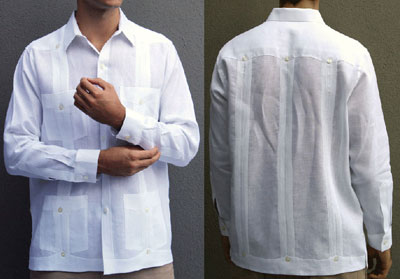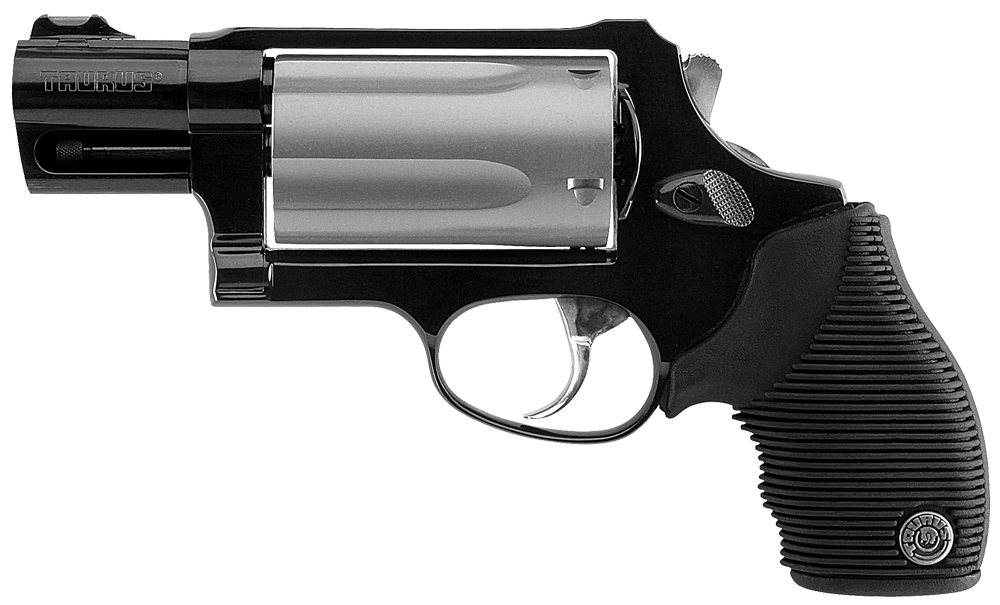Defensive Shotgun Ammo – Frequently Asked Questions (FAQ)
The purpose of this FAQ is to discuss the questions that frequently come up in regards to the defensive use of the shotgun. We will not discuss the best loads for hunting, clays, or other sporting uses, but instead will specifically talk about defensive loads, and even more specifically, loads for home defense.
What is the best defensive ammo?
When considering the defensive use of the shotgun, we want ammunition that will reach the FBI minimum of 12 inches of penetration. This minimum is explained in this section (http://ammo.ar15.com/project/Self_Defense_Ammo_FAQ/index.htm).
The only shotgun ammunition that will consistently reach the FBI minimum of 12 inches penetration is buckshot or slugs.
What is the difference between birdshot and buckshot?
The only difference is in the size and weight of the pellets.
Shot sizes are listed here:
Numbers 9, 8, 7 ½, 6, 5, 4, 3, 2, 1, B, and BB are the most common sizes of birdshot, with the larger numbers representing the smallest sized birdshot.
Buckshot comes in sizes #4, 3, 2, 1, 0, 00, and 000 buckshot. Number 4 buck is the smallest, and each size is larger as we go up the list.
0 buck is called “Ought buck”, 00 is called “Double ought buck, and 000 is called “Triple ought buck”.
Simply put, #4 buckshot and larger is called buckshot. Any pellet size smaller than #4 buckshot is called birdshot.
There is sometimes some confusion, as there are both #4, 3, 2, and 1 birdshot, and #4, 3, 2, and 1 buckshot. But they are not the same, as the buckshot are much larger.
Doesn’t buckshot over-penetrate, and doesn’t it penetrate too many walls?
Any ammunition that will reach the FBI minimum of 12 inches penetration in ballistic gelatin (and in bad guys), will also penetrate several interior walls in a home. See here: (http://www.theboxotruth.com/docs/bot14.htm)
Until someone invents a phaser, like on Star Trek, any ammunition that will effectively Stop a bad guy, will also penetrate several walls.
Shouldn’t we use birdshot, so that it doesn’t penetrate several walls?
No, because no birdshot load will reach the required penetration to reach vital organs or the central nervous system. Birdshot makes shallow and gruesome wounds, but it has been shown to be a very poor Stopper.
“Might” birdshot work as a defensive load?
Sure, it “might” and sometimes has worked just fine. But why take the chance with “might work”, when “will work” is available? Buckshot is readily available, so why not use the “best” available load?
Would larger birdshot penetrate better than smaller birdshot?
Yes, it will. Penetration is a factor of the mass of each individual pellet, and the larger the individual pellet, the greater the penetration, if the velocity is the same. So, #6 birdshot will penetrate more than #9 birdshot, and so on. But no birdshot will reach the 12 inches of penetration required to be effective.
Wouldn’t a load of birdshot “act like” a slug at close range?
No, it will not. For instance, each pellet of #6 shot weighs approximately 1.8 grains. If there are 333 #6 pellets in a shotgun shell, the total weight of the birdshot is 600 grains.
Some folks have mistakenly said, “A load of #6 is like getting shot with a solid piece of lead weighing 600 grains”.
But this is not the case. This is because that 600 grain load is composed of 333 individual #6 sized shot, each weighing 1.8 grains. And the penetration of the shot is dependant on the weight of “each pellet”, not the total weight. And a 1.8 grain pellet will not penetrate very far into ballistic gelatin or a bad guy.
What about “exotic” shotgun loads?
Loads such as fletchette rounds, wired-buckshot, and other exotic rounds have been tested and they failed to reach the required penetration, or were not an improvement on lead buckshot. They also tend to be very expensive, and do not improve on lead buckshot.
What is the best buckshot for defense?
The best buckshot is #1 buck. This is based upon the number of shot in a shell and the total frontal area impacted by that load. See the http://ammo.ar15.com/project/Self_Defense_Ammo_FAQ/index.htm, and look all the way to the bottom, where this is explained in detail.
What if I can’t find #1 buckshot, what is the next best load?
#1 buckshot is sometimes difficult to find, but 00 buckshot is almost as good and is readily available and produced by many manufacturers. Therefore, 00 buckshot is usually the recommended load for defense.
However, as noted by DocGKR, “Pretty much any buckshot from 1 to 000 works just fine––figure out what works best in your weapon, purchase enough for practice and field/duty use, get extensive shotgun training from a good instructor, then stop worrying about specific loads, as it just doesn’t matter that much.”
UPDATE 8/20/2011: Federal has just released a #1 buck load that has been specifically designed for self-defense scenarios. According to DocGKR, this new Federal LE132-1B #1 buckshot load offers IDEAL terminal performance for LE and self-defense use and is the best option for those who need to use shot shells for such purposes.
Why not use slugs for home defense?
Slugs are very effective rounds in a shotgun, but for home defense, they have the problem of being great over-penetrators. They will go completely through a bad guy and still have enough energy to do damage on the other side of him. They penetrate more than is needed to be effective Stoppers. Buckshot is a better load for home defense.
What is the effective range of buckshot?
Buckshot is effective from the muzzle to around 40 yards. It can be effective further, but most loads will have problems with the pattern opening up too much past that range, and many of the buckshot will miss the target. Since we are responsible for every projectile that goes down range, we do not want any of the buckshot to miss the target. Tighter patterns are desirable.
What is the effective range of slugs?
Slugs can increase the effective range of a shotgun to around 80 to 100 yards. If a scope is used, they can be effectively accurate at even longer ranges.
Sabot slugs (pronounced say-bow) are slugs designed to be used with rifled shotgun barrels and can extend the range even farther.
Do I want large or tight patterns with buckshot?
Tight patterns are desired because we want all of the buckshot to impact the target. And projectiles that miss the target will continue down range, and will cause us to violate Firearms Safety Rule #4 – Be sure of your target and what lies beyond it.
Isn’t a wide pattern an “advantage” of using a shotgun?
No, it is not. It is a definite advantage when hunting and wing-shooting birds with birdshot. But when used for home defense, we do not want any projectiles to miss the target, and this requires tight patterns. Buckshot does not “act like one slug”. Therefore, even if the pattern is tight, the individual buckshot will each create its own wound channel when it impacts the target.
Author: DAVID COLBURN
The Stylish Man’s Guide to Concealed Carry
The Stylish Man’s Guide to Concealed Carry
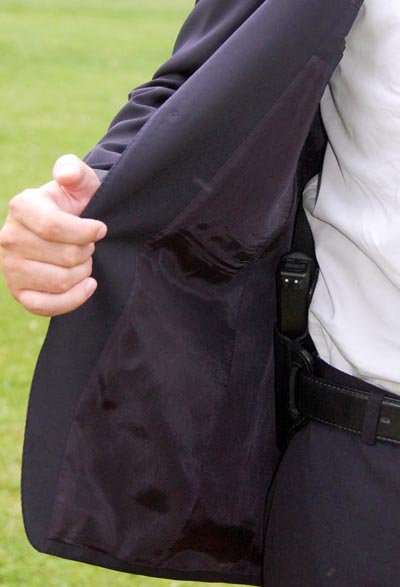
How to arrange good-looking clothing around the decidedly non-standard bulge of a handgun is a topic worth looking at. It’s something that a whole range of men need to think about: police detectives, security guards, entrepreneurs in dangerous countries, and even your average American civilian who prefers to be armed.
“Concealed carry” exists for a number of reasons. When you’re doing it, you want to be living up to both parts of the phrase: you want to be carrying, and have access to, a firearm, and you want it to be discreetly hidden until such time as you need it.
For some men, any jacket long enough to hide a holster is sufficient. But for most men, concealed carry needs to fit other societal expectations:
- Most plainclothes peace officers will have specific dress needs — either a respectable suit or blazer to give them out-of-uniform authority, or in some cases a disguise to help them blend into their environment.
- Security guards are almost always expected to dress professionally, as much for the comfort of their employer’s clients as anything else. Banks and government buildings need high security, but prefer a discreet man in a blazer as opposed to a uniformed, paramilitary-looking trooper looming over their customers.
- An armed civilian gets less hassle if he doesn’t fit the stereotype of an armed threat. A trenchcoat and combat boots conceal a weapon, but it doesn’t really conceal the likelihood that you’ve got a gun under there. Bringing a little men’s style into the equation makes the “concealed” part of “concealed carry” a lot more effective. Plus, it’s the law in most states that if you’re carrying heat, you conceal it. Editor’s Note: If you’re a civilian, be sure to check with your local and state laws before you begin carrying a firearm. Most states require citizens who wish to carry a firearm to obtain a concealed carry license; there also may be restrictions on where you can carry your firearm.
There are many reasons to think about both concealed carry and style in the same picture. This article lays out the quickest and best steps to making your concealed carry experience both practical and stylish:
- Step 1: Choose Your Weapon
- Step 2: Choose Your Method of Carry
- Step 3: Choose Your Outfit
- Step 4: Talk to Your Tailor
So let’s take it step by step:
Step 1: Choose Your Weapon
Concealed carry means striking a balance between firepower, ammunition, and size. You inevitably end up making a sacrifice in one area or the other — it’s more a question of personal needs and tastes than it is a matter of which is the “best” weapon.
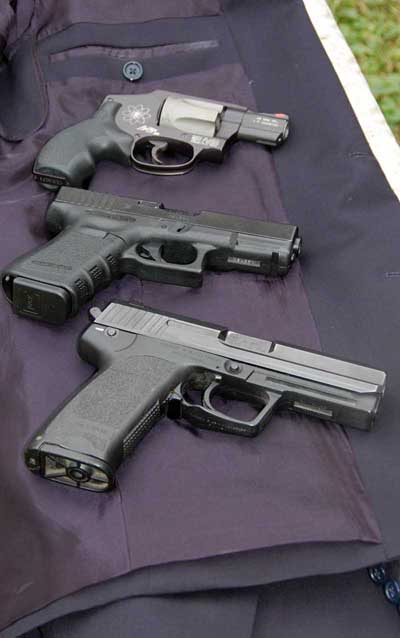
But for choosing a handgun, which is what most men will be carrying when they carry a firearm in public, here are a few factors worth thinking about:
Magazine Size and Shape
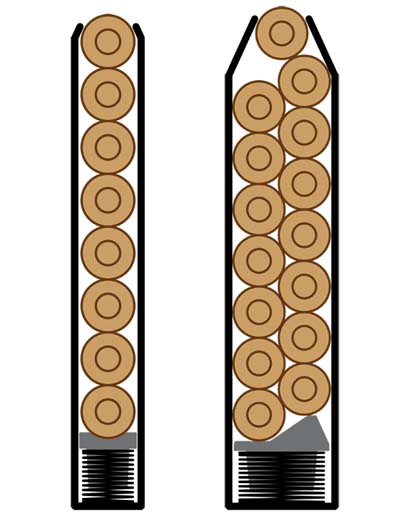
A single-stack magazine is always easier to conceal than a double-stack.
The most important dimension of a pistol for concealment purposes is the width — how fat the barrel and the grip are. That’s what’s going to make a bulge under your clothing, more than the length or even the weight of the gun.
As a result, it’s better to have a single-stack magazine of relatively low caliber, at least in terms of concealment purposes. If that’s just not going to meet your needs in terms of firepower or ammunition, you get a slightly thicker magazine and cope as best you can.
The disadvantage of a smaller grip/magazine (aside from limiting your shots) is that a powerful handgun with a small grip has a ton of kick. The shorter the grip, the less leverage you have, making aiming trickier (especially follow-up shots after the first). A heavier frame can help compensate for a smaller magazine, and won’t alter the concealment in most holster types (though it will create more of a sag if you’re carrying it in your pocket or by another non-holstered method).
Look for a balance that suits your needs, but from a concealment standpoint do be aware that a longer grip/magazine is harder to hide, and may end up poking you depending on your carry method.
Caliber
This is one that some people have very strong feelings on. Some people will swear that you always want the maximum firepower you can carry; other people are comfortable with the idea that no bullet is a bullet anyone wants to take, and therefore even a tiny holdout pistol is plenty for self-defense.
You’ve got to make that call yourself. But the reality is, smaller caliber handguns are easier to conceal both because of the magazine size and the barrel width and length.
It’s not a universal scale — a .45 could be more concealable than a .38 depending on the shape and size of the grip and magazine — it’s just something you need to be thinking of as a firepower/concealability trade-off.
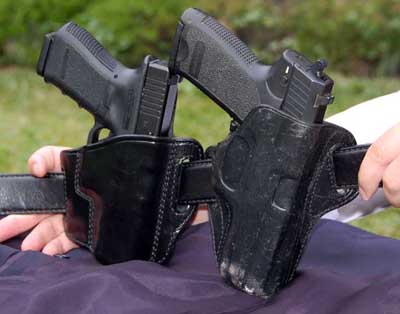
Exterior Construction
To use a very untechnical term, some guns are made with lots of “fiddly bits.”
You know what I’m talking about — everything from sighting notches to bulky safety catches to raised lettering on the barrel. Any of those is going to make the gun harder to conceal.
Weapons that are purpose-designed for concealed carry (and a number of manufacturers do have models specifically for the CC market) tend to be smooth-sided and streamlined. Look for designs with minimum “fiddly bits.” It’ll help both your concealment and your draw.
Barrel and Magazine Length
It’s a secondary consideration next to width, but the length of the pistol (in both directions) does matter. Extended magazines are hard to hide, and tend to poke you while you carry them.
Longer barrels give you range and accuracy, and longer magazines give you more shots without reloading, but the reality for most of us is that neither of those is a huge consideration. Unless you’re in an active military or paramilitary kind of situation, you — hopefully — won’t ever need more than a shot or two, even in the very worst-case scenario. Most of the time you won’t even need that.
So when possible, err on the side of a smaller weapon and magazine for the sake of concealability and comfort. It’s one of those trade-offs where you have to know your own needs, but don’t just default to the biggest magazine and longest barrel available for your handgun of choice.
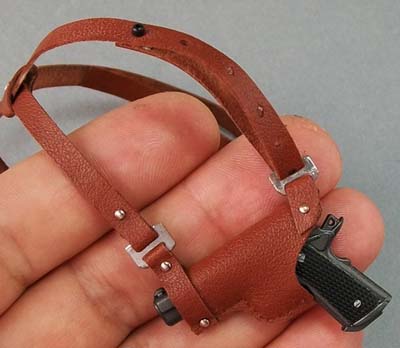
So Which Gun is the Right One?
There’s no single right answer to that question. But, most men with concealed carry experience will recommend something along the same basic lines:
- low to mid-caliber ammunition
- single-stack magazine (or very slim-profiled revolver)
- slim grip
- short barrel
- smooth exterior
- light weight
Here are a few of the more popular models that get tossed around in discussions of concealed carry — this is by no means an exhaustive list, nor should any of these be taken as strong recommendations, but they’re good examples of the relatively broad range of options you have:
- Glock Model 19
- NAA .22 Magnum Mini-Revolver
- Kahr PM9
- Smith & Wesson M&P series
- Walther PPS
- Springfield XD
There are many more beyond these. But the important step here — and this is key — is to know which one you carry (or will be carrying) before you start planning your wardrobe around it, and especially before you have any tailor-made adjustments. You get the maximum benefit when you can have clothes tailored specifically for your gun and holster of choice.
Which brings us to our next step:
Step 2: Choose Your Method of Carry
Just like handguns, holsters come in every style imaginable. You might own one, or you might own a dozen. Depends on your needs. But for purposes of deciding what to wear and how to conceal your gun, you’ll want to know where you’re going to wear it, and in what kind of holster.
Regardless of your method of carry, one key piece of equipment is a very sturdy belt. This not only helps keep the gun in place and prevents your trousers from sagging, it’s also an important safety feature. You don’t want the holster shifting and you certainly don’t want the belt buckle popping open because of the extra weight or the jerk of your draw. Invest in something broad and made of sturdy leather or ballistic nylon. Most stores that sell holsters will also sell belts designed for them.
Paddle Holster, Hip Carry – OWB (Outside the Waistband)
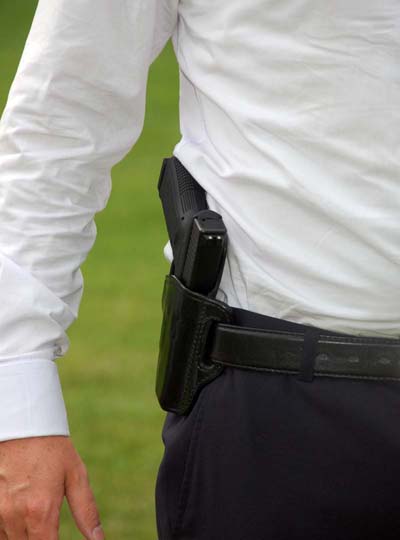
- Advantages: Simple, cheap, and quick to draw
- Disadvantages: Bulky and hard to conceal
This is the most typical way for peace officers and soldiers to carry their primary handgun: a “paddle” style holster (basically the outline of the gun, with a flat “paddle” backing that rests against your body) worn at the belt line, with the pistol pointed down the thigh. The magazine points toward the rear of your body, and the grip is typically angled a bit forward.
The disadvantage for concealed carry should be obvious: it’s going to be very easy to accidentally reveal a gun that’s worn up by your front pockets. A long, loose jacket will do the trick, but as soon as you unbutton/unzip the front it only takes a stiff breeze to expose your holster.
It’s also hard to conceal the bulge if you wear a buttoned suit or sports jacket, even one tailored for the holster. You can pull it off with a small holster and a small gun, but expect to look pretty heavy around the hips when you do it.
Paddle Holster, Behind the Back – OWB (Outside the Waistband)
- Advantages: Simple, cheap, and still fairly quick to draw
- Disadvantages: Still bulky; still requires at least a jacket to conceal
An obvious solution to the hip-carry problem is to keep the same simple holster but move it to the small of your back.
This removes the problem of an unbuttoned jacket brushing back to expose the pistol. The whole back of your coat/jacket would have to flip up to reveal your firearm. It makes a suit or sports jacket much more effective concealment, especially if it’s cut a bit long in the rear. A little looseness also looks more natural on the back of your jacket than it does at the sides.
Drawing a pistol from behind your back is a bit slower than off the hip, but still not too cripplingly inconvenient. There is growing concern, however, that a gun in the small of your back can cause back injuries if you fall or are struck hard where the gun rests — many police departments mandate that nothing except soft items (gloves, CPR kits, etc.) be carried directly in the center of the back for this reason.
So while the simple paddle holster worn behind the back is an effective method of concealment, and still a favorite for a lot of concealed carriers, it comes with some safety cautions. And, of course, it requires you to sit down pretty gingerly, if at all.
Shoulder Holster
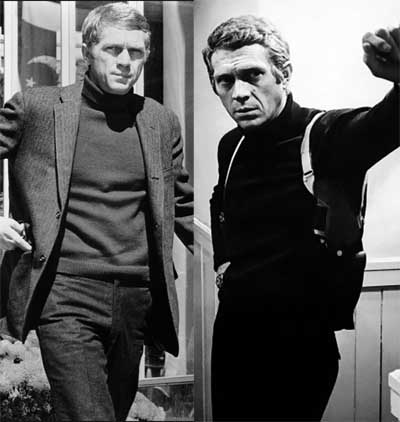
- Advantages: Decent concealment, faster draw than behind the back
- Disadvantages: Uncomfortable, easy to accidentally expose
The shoulder holster, which keeps the handgun tucked under your armpit and against your upper ribs, is a popular one with law enforcement (and one made famous by Hollywood and television cops). It’s a good choice for easy access, and only slightly slower to draw from than a holster on your hip.
Unfortunately, it’s also not that great for concealment. A suit jacket or blazer angles back toward the shoulder — you’ve usually only got a few inches between the butt of your pistol and the opening of your jacket. Unbuttoned, it’s very easy for the jacket to slide back far enough to reveal your weapon.
Typically, your draw with a shoulder holster also has to cross your body, with the barrel sweeping in almost a full semi-circle. They’re not allowed on many firing ranges for this reason — instructors and managers don’t want to risk other people being placed within the line of fire as you draw. It’s important to have very good trigger control and be careful with your safety when you’re drawing from a shoulder holster.
Due to the concealment drawbacks and need for trained habits, shoulder holsters tend to be best for people like plainclothes detectives and security guards who are being discreet, but don’t need to effectively disguise the fact that they’re carrying a weapon, and tend to have more firearms training than your average civilian.
Sheath Holster IWB (Inside-the-Waistband)
- Advantages: Good concealment, doesn’t require a jacket
- Disadvantages: Requires tailored trousers
IWB holsters (the most common name) carry the gun tucked into the trousers rather than worn outside them. They make special holsters for this, which are worth investing in. Whatever you may see on TV, don’t go tucking guns into your pants without a holster unless you absolutely have to. Most IWB holsters can be positioned anywhere on your back, allowing for basic behind-the-back carry or for something shifted to one hip or the other.
The advantage here is that you only have to hide the handle of the gun, rather than the whole thing. A smooth holster inside custom-widened trousers conceals most of the bulk for you. Just a loose T-shirt will do to hide an inside-the-waistband carry in a pinch.
The downside is that it’s an expensive and a fairly uncomfortable option. You need the tailored trousers, the specific holster, and the willingness to stand and sit with a gun barrel pointed down your rear end.
Pocket Carry
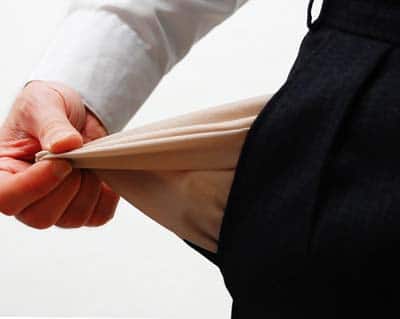
- Advantages: Good concealment, flexible positioning
- Disadvantage: Requires a small gun, concealment can vary; gun may shift
Pocket carry is what it sounds like — sticking a gun in your pocket. How effective the method is at concealment depends on how large your pockets are, how thick their lining is, and what style they are — big patch pockets with thick lining and a closing flap will hide a gun fairly effectively, while the back or hip pockets of your jeans will not.
The biggest disadvantage of carrying your gun in your pocket is that, unless you have an internal holder sewn into the pocket (which we recommend if you plan on pocket carrying regularly), the gun will shift around as you move. This can slow your draw, make the gun more likely to “print” (show its outline through the fabric), and even be a safety hazard.
If you wear a garment with large, easily-accessed pockets low on your midsection, you can position a gun for off-hand draw as well. A side-slit pocket near where your off-hand naturally falls is about as easy access as you’re going to get for emergency off-hand draw if your primary arm is incapacitated.
Many people prefer to use pocket carry for a back-up or holdout weapon, paired with another method of concealed carry for a primary weapon. If you do pocket carry, be sure that the gun is snug in the pocket, and have a tailor sew a holder into the interior if necessary. You don’t want your gun falling out, or to go to draw it and find it upside down and backwards in your pocket.
Ankle Holster
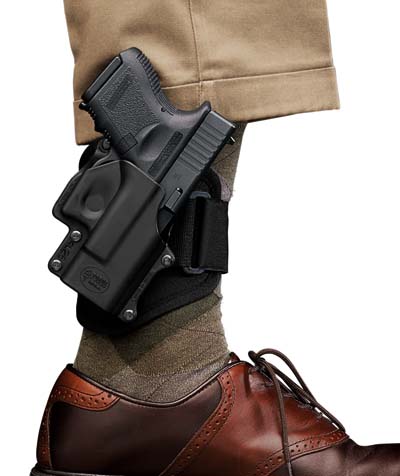
- Advantages: Excellent concealment
- Disadvantages: Very slow draw, limited to the smallest handguns
An ankle holster is a traditional holdout option for very small handguns. It requires nothing fancier than boot-cut jeans to conceal, and may even be missed by careless pat-downs. But it limits you to little more than a derringer (though some police carry sub-compacts, usually in specially-tailored trousers), and takes several seconds to draw from, making it a backup option rather than a primary method of carry for most men.
Holdout holsters can also be strapped to a forearm, inner thigh, or other unusual point for maximum concealment. Again, however, these are difficult to draw from and can only conceal the very smallest handguns out there.
Step 3: Choose Your Outfit
Once you know what gun you’re going to carry and where you’re going to carry it, you’re ready to plan an outfit that both conceals the weapon and looks sharp on you.
Different men have different sartorial needs, just as they have different firearm needs. The good news is, there’s a concealing outfit for every standard of dress from James Bond’s tuxedo all the way down to cargo pants and a T-shirt.
Business Concealed Carry
Suit-and-tie concealed carry is more common than you might think. Businessmen who travel frequently like to take personal protection along with them, and some politicians actively advertise their habit of carrying a weapon as a matter of principle as well as protection.
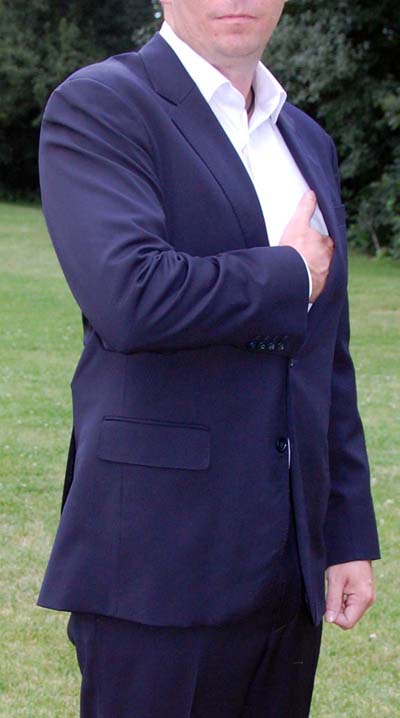
Happily for all of them, a business suit is a fairly effective method of concealment. It’s actually one of the better options out there, short of a full length coat. You can use pretty much every type of holster:
- Paddle on the hip (with the jacket buttoned; jacket should be tailored for the bulge)
- Paddle behind the back (a long jacket easily conceals the whole thing)
- Inside the waistband (practically invisible under a jacket)
- Shoulder/armband holster (concealed as long as the jacket’s buttoned)
- Ankle holster
The biggest consideration for a man in a suit is usually whether he needs to be able to take the jacket off or wear it unbuttoned. An unbuttoned suit jacket can still conceal either kind of behind-the-back carry, and of course a holdout, but will probably reveal a holster on the hip or under the arm if the wearer moves much.
Men who need to be able to take their jacket off and still keep a weapon hidden should wear trousers tailored for inside-the-waistband carry and a shirt with a long, loose back that can be untucked or draped over the butt of the gun.
Three-piece suits are also popular with concealed carriers — the waistcoat can be cut deliberately long to hide an inside-the-waistband carry.
If you’re actually likely to be in any sort of combat situation, be sure to swap a clip-on tie with a breakaway clip for the hand-tied version. They’re not quite as nice-looking, but someone who’s working as a bodyguard or security officer doesn’t need to be offering a free chokehold to potential assailants.
Business-Casual Concealed Carry
A step down from the suit and tie look, business casual is the style preferred by most men who carry a handgun as part of their job — plainclothes cops, body guards, security guards, and so forth. A business casual outfit looks respectable and often includes a conveniently concealing jacket, making it all around useful for people in that sort of line.
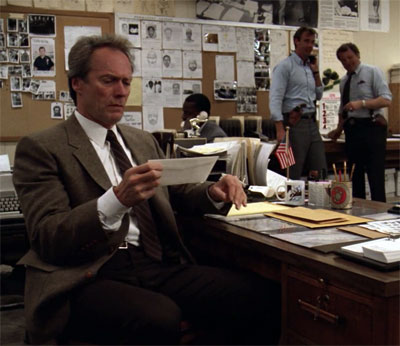
Civilians should also take advantage of the blazer-and-slacks combination. It gives you plenty of places to conceal a weapon, and it has the added advantage of making you look well-dressed relative to the average guy on the street. People looking at you are going to be thinking, “Hey, he looks sharp,” not, “Hmm, I wonder if he’s carrying a gun.”
A sport coat or blazer jacket and long trousers of any kind offer basically the same concealment as a suit jacket. You also have the option of wearing either an unmatched “odd vest” or a longer sweater vest, either of which will hide the handle of a gun worn inside the waistband without the need for a jacket.
Dress-casual concealed carry can be made to look quite casual — think Dirty Harry, Miami Vice, or Steve McQueen in Bullitt, all of which feature shoulder-holstered policemen in jackets and sharp shirts.
Of course, if you’re planning on serious physical activity or movement, don’t expect a suit jacket or blazer to provide much concealment. But presumably at the point where you have to sprint, concealment is no longer the chief priority.
Casual Concealed Carry
If there’s no dress code to observe, you can wear almost anything that conceals a weapon. That said, don’t default straight to baggy jeans and an untucked T-shirt — it works, but it doesn’t do much to disguise the fact that you could be armed, and it’s neither as practical nor as attractive as some of your other options:
- Concealment jackets – These are coats made by arms manufacturers (or affiliates) specifically for concealed carry. SIG makes one designed to look like your basic work jacket, similar to a Carhartt or Dickies, making it very unobtrusive almost anywhere in America. Concealment jackets have large internal pockets, usually Velcro-sealed, with loops or hooks for a handgun. They’re great for outdoors concealed carry, but get both uncomfortable and obviously out of place if you’re indoors for any length of time.
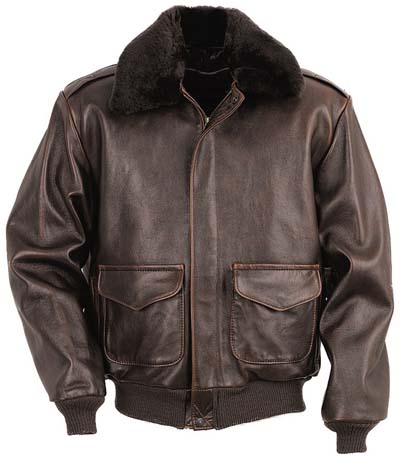
- Leather jackets – A classic style and excellent concealment, opt for one that’s on the longer and looser side. Bomber-style jackets are perfect for concealed carry, since they have a padded lining that conceals bulges and a longer waist than moto-style jackets.
- Denim or wool coats – Lightweight coats are comfortable most of the year and can conceal any style of holster except the paddle (longer coats will even cover that). Just be cautious of tight-fitted waists, typical on jean jackets, unless you know you’re going to be using a shoulder holster exclusively.
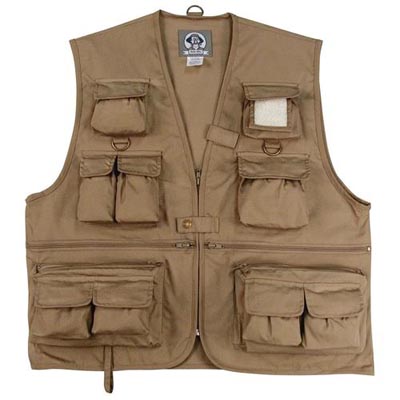
- Safari/photographer’s vests – The thigh-length, multi-pocketed vest typical among journalists and photographers is an ideal concealed carry garment. It’s long enough to hide holsters at the waistband, thick enough to disguise bulges, and features plenty of pockets for ammunition or even a smaller holdout weapon. There’s a reason they’re popular with people traveling in rough countries — that said, they’re also the most recognizable “concealed carry” garments, and may draw attention from people looking for concealed weapons.
- Casual shirts worn untucked – Just a plain white dress shirt is plenty of concealment if you’ve got an inside-the-waistband holster. Wear any sort of collared or uncollared shirt loose and untucked and you’ve got enough concealment to hide the grip of a handgun from casual observation. It’s a good option when you’re carrying in places where a jacket or blazer would be conspicuously overdressed. Remember the guayabera shirts we just wrote about?
- Sweatshirts/hoodies – These are pretty much everywhere, and they add plenty of bulk around the waist that can hide even a large handgun. Just be aware that men over 30 wearing a hoodie look like they’re trying a little too hard. It’s good gun concealment, but it’s not magical urban camouflage that will make people think you’re from the streets if you’re not. To learn more about your options check out this classic AOM article on sweater styles for men.
Step 4: Talk to Your Tailor
Bizarrely, this is the step most men skip — even though the cost of alterations is usually less than the cost of a holster, and certainly less than a decent handgun.
Don’t skip it.
A single purpose-made garment is better concealment than any half-dozen layers of unaltered clothing. Tailors have their jobs for a reason.
The key here is to find a tailor who’s willing to work specifically on concealed carry issues. Always ask ahead of time — it’s very bad form to walk into a stranger’s shop and pull out a gun unannounced, even for demonstration purposes. Set up an appointment ahead of time and make it clear that you’ll be bringing a gun.
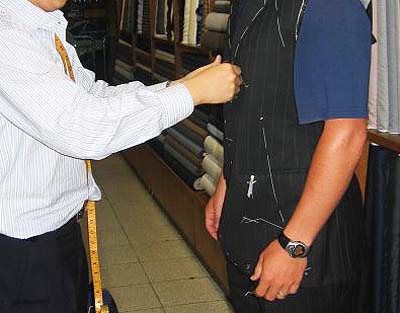
Some basic changes a tailor can make that go a long way in concealed carry include:
- An extra layer of canvas and lining in the jacket increases stiffness, which reduces the “print” the gun makes through the outer fabric.
- Extra length in the back (you can usually get away with up to an extra inch before it starts to look odd) helps keep a paddle holster concealed when you move or raise your arms.
- Small armholes make the jacket rise less when you move your arms, making them good for paddle holsters. Large armholes, on the other hand, help hide a shoulder holster, and the hem of the jacket lifting doesn’t affect shoulder carry. Pick whichever you need for your holster.
- Small pockets can be added inside the lining at the bottom front corners. You can slip a fishing weight or large coin into the pocket to help keep the jacket in place as you move, preventing any inadvertent holster-flashing.
- If you’re planning on pocket-carrying, a small cloth sling or loop can be added inside the pocket to hold your pistol at the proper angle and keep it from sliding around.
- Select a textured fabric to help break up lines, especially if you carry a bulkier gun. Herringbone, birdseye, and rough tweed all help reduce the visibility of the outline. Stay away from stripes, which emphasize any bulges.
- A stiffened rod or strap can be sewn into the front edge of the jacket, making it easier to flip out of the way when you do draw but keeping it lightly weighted down at all other times.
- Extra pockets can be added to any garment for spare ammunition. If you plan on carrying one specific type of magazine, bring an empty along and have the pocket made to fit it.
- Get a tight-fitted shirt if you use a shoulder holster, to prevent the holster from tugging loose fabric into conspicuous wrinkles across the front of your body.
A good tailor will always take the measurement of the gun itself and of you wearing the gun. Be sure to have all components in place, especially if it makes a difference in size.
Once you have a jacket and trousers (or other garment) tailored for concealed carry, the rest is in your personal style and mannerisms. Carry yourself calmly and with confidence, and dress tastefully but blandly, and you should be able to slip past everyone’s notice without the possibility that you’re armed ever crossing their mind.
The worst thing a concealed carrier can do is fiddle with his clothing, especially where the gun is hidden, so keep your hands at your side and try to look bored. In the ideal concealed carry situation, no one knows you have a gun until you’re using it — and if you’re lucky, that means no one ever knows you have a gun.
Thank You
I would like to extend a big thank to the many law enforcement professionals, military men, and citizens whom I consulted with on this article.
______________
Written by Antonio Centeno, Founder Real Men Real Style
Want to learn more about style? Watch my men’s style videos here.
The OODA Loop and Situational Awareness
The OODA Loop and Situational Awareness
O ne of the most common themes taught in defensive firearms classes is situational awareness. First designed by Col Jeff Cooperin the 1970s, the situational awareness chart represents the degrees of awareness that a person experiences in relation to their surroundings.
ne of the most common themes taught in defensive firearms classes is situational awareness. First designed by Col Jeff Cooperin the 1970s, the situational awareness chart represents the degrees of awareness that a person experiences in relation to their surroundings.
Cooper’s chart is based on a color code from white to red.
Condition White signifies being completely oblivious to your surroundings. This is referred to as “daydreaming” or bei ng “distracted”. This condition is probably responsible for more visits to the emergency room or the morgue than any other; not only in a life or death situation such as a gun fight, but with regard to car accidents and industrial accidents.
ng “distracted”. This condition is probably responsible for more visits to the emergency room or the morgue than any other; not only in a life or death situation such as a gun fight, but with regard to car accidents and industrial accidents.
Condition Yellow is a slightly more elevated state of awareness. In Condition Yellow, the subject is aware of what is going on around him, but has not identified a potential threat. This is a relaxed state of general awareness.
Condition Orange is the next level up and basically means that a potential threat has been recognized. This could be a late night walk to an ATM and coming toward you is someone with his hands in his pockets. He may just be another user of the ATM fumbling for his wallet or a potential robber. What is important is seeing the potential in his actions and formulating a plan, being ready to escalate if necessary or dial back down to Yellow if he proves to be harmless.
Condition Red is the final step before taking action. If the man walking to the ATM produces a knife and demands your money, you will have to put your plan into place. This is not always the fight, itself. Sometimes your plan might entail identifying avenues of escape at this point.
What goes hand in hand with Cooper’s color code is the OODA Loop, which stands for Observe, Orient, Decide and Act. OODA is a decision-making cycle that was conceptualized by Air Force Colonel John Boyd in the Korean War.
Boyd’s concept states that the success in any conflict is all about making correct decisions quicker than your opponent can. The strength of following the OODA Loop is based on the fact that we constantly perform transitions through OODA Loops on a daily basis.
The OODA Loop can be broken down into four stages:
All of these stages are interrelated and can overlap. In the real world situations and even environments change course constantly. From the observation phase, data is collected and then analyzed in the orientation phase. The user then makes their decision based on available choices and in turn acts on them.
The only way to shorten your OODA Loop is through training, this is known as conditioned reflex or muscle memory. This is whymalfunction drills are important in firearms training. If you can work them into your practice sessions, you will know how to act when they occur at the “moment of truth”. By performing drills like these throughout your firearms training sessions, you will begin to perform them as second nature, which will essentially shorten their phase in the OODA Loop.
When it comes to fighting for your life, it is essential to practice and hone the simplest and most natural “techniques” or movements through constant repetition until they become instinctive as opposed to reactive. Then when those techniques are performed in a real world scenario, they will most certainly be extremely effective. Think of the old adage in this case: “Action is faster than reaction.”
Simply put, the untrained will have slower phases of the OODA Loop. This can often be seen at shooting matches when seasoned shooters perform the “tap-rack-bang” drill while the novices may simply stare at a non-working firearm.
Beyond physical training with a firearm, mental preparation can shorten each section of the OODA Loop while transitioning through the color chart of situational awareness. Going back to our ATM scenario, as you transition between orange and red, you are in the decision stage of the OODA Loop. You can sharpen this by playing out similar scenarios in your head well in advance. Granted, you may not fathom every possible outcome, but the simple act of conceptualizing how you will respond to an attacker will shorten your actual decision making process when the time comes.
Do you use Cooper’s color codes or the OODA loop in your life? Tell us about it in the comments.
OODA Loop Photo Credit: Patrick Edwin Moran
5 Things you should know!

The best way to survive an armed encounter is to avoid it altogether. The second best way is to deter the threat without firing a shot. However, the world is a dangerous place, and we must prepare responsibly for every eventuality and equip accordingly. If the first rule of being prepared is to have a gun, then the second rule is to ensure that you have every opportunity to prevail.

Range time is an important activity for any defensive shooter. Stance, sight alignment, breath control and trigger control are critical components of accurate shooting. Spend time at the range, and lots of it. But be aware that the time you spend does not fully prepare your for real-world defensive shootings.
In a lethal force scenario, everything changes. You’re not at the range anymore. The controlled environment no longer exists. You are defending your life or the life of another. Your heart is pounding, your target may be cloaked in darkness, you are fixated on your target and your iron sights are an afterthought. All of this happens in a matter of seconds and within only a few feet.
With a laser sight on your handgun, you have access to a targeting and threat de-escalation tool that can help you overcome challenges such as darkness, close range, time, movement, and the threat itself. Survival is all about giving yourself the tools to make quick, yet informed, decisions when your body and brain experiences changes outside of your control. And should you fire your weapon, your shots will reach their intended target.

If you are attacked, or you draw your handgun to prevent violence, powerful changes surge through your mind and body. A powerful “fight or flight” response kicks in which you cannot control. Your heart rate skyrockets, muscles tense, and vision narrows. These natural changes prepare you for physical battle or a swift move to cover, yet they limit your ability to shoot accurately.
The most dramatic change you’ll experience is the loss of fine motor skills. Your physiological reactions prepare your body to use the powerful muscles of the arms, legs and torso to fight or escape. None of these natural reactions are designed to help you operate a handgun effectively. You’ll struggle to hold the gun steady, struggle to pull the trigger smoothly, and struggle to line up sights accurately in the same ways you practiced at the range.
Most people involved in shootings report never seeing their sights. It’s no mystery why. How do you focus on the threat AND your sights at the same time? With reliable state-of-the-art technology like Crimson Trace laser sights, you simply move your sights onto the target by projecting a laser dot. This allows you to assess the threat, overcome the loss of fine motor skills, and place accurate shots during critical situations. Also, by placing a laser on your target, you communicate a crystal clear message: you can both walk away.

U.S. law enforcement officers are some of the best-trained shooters in the world, but hit ratios from shootings in the field are staggeringly low. National Institute of Justice data shows that officers using traditional sighting and training methods hit their mark only about 25% of the time when lethal force engagements ensue.
Why so low? Consider that 80% of shootings occur in low-light situations, most involve movement of officer or subject, and with the stress of a life or death situation, and it’s easy to see why so many rounds miss their targets. The challenges faced by law enforcement officers and the challenges faced by responsible citizens defending themselves aren’t that different – with one glaring exception: the officers are trained professionals.
Crimson Trace laser sights are used by hundreds of law enforcement agencies and military units worldwide. The numbers don’t lie. Agencies using Crimson Trace lasers have achieved hit ratios of over 90% in officer-involved shootings. That’s a phenomenal 300%+ improvement. The bottom line is this: laser sights are an invaluable tool that improves your ability to see, evaluate, aim, and successfully hit.

Technology exists to help shooters of all skill levels improve their confidence, speed and accuracy. However, with so many options now available, it can be very difficult to distinguish between serious equipment and toy-like gadgets. Laser sights were once large and impractical, had terrible mounting options, offered clumsy activation options, or were cheap and flimsy. Crimson Trace changed all that. No personal protection handgun is complete without a laser sight. Thousands of Crimson Trace customers know this to be true.
Nearly 20 years ago, Crimson Trace pioneered Instinctive Activation®, the single largest breakthrough in making laser sights the most effective handgun targeting tool for self-defense handguns in the world. Instinctive Activation simply means that when the handgun is held in a natural firing grip, the laser springs to life instantly. This feature allows the shooter to be on target, as soon as they draw their weapon. No button switching, no fumbling for levers, and no valuable time lost. It’s why we say, When You’re Holding It, You’re Aiming It™.
Instinctive Activation is offered by Crimson Trace product lines including: Lasergrips® and Laserguard®. Lasergrips replace factory grips in moments, or are mounted seamlessly to the frames of modern polymer-framed pistols. Laserguard models are designed for smaller concealed carry guns without factory grips by attaching to the trigger guard. Crimson Trace offers nearly 150 laser sight models, many with Instinctive Activation.

Responsible armed citizens are one of the reasons for America’s decreasing violent crime rate. It is estimated that as many as one million crimes are prevented each year because of armed citizens. Most of these crimes are prevented without a shot being fired. The mere presence of a firearm was enough to encourage the criminal to change their mind. Unfortunately, not all attackers give up without a fight.
Maybe they’re unaware that their prey have guns. Maybe they figure their mark won’t actually shoot. Most likely of all, they presume their victim is incompetent and unlikely to hit anything. Remember one thing about the aftermath of a shooting:Whether justifiable or not, your life will change forever. Your guns will be seized, the police will write you up in their reports, you may be sued in civil court and possibly prosecuted in criminal court. You will probably be arrested.
Should you find yourself in an armed self-defense situation, unquestionably the BEST outcome is for the criminal to flee in fear of their own life – without shots being fired. How can you increase the odds that the attacker will give up before you shoot? Use a laser sight. Uncooperative criminals have been shown to comply better with a red (or green) laser dot painted confidently across their chest. Will it stop an attack every time? No. Is it designed to be a non-lethal tool? No. Will it place the odds in your favor? Yes. It’s precisely the reason why we say that laser sights Help Bad Guys Make Informed Decisions™.
10 Tips for Choosing a Concealed Carry Handgun
10 Tips for Choosing a Concealed Carry Handgun
1. Find a Friendly, Knowledgeable Gun Shop
When you go to purchase your first concealed carry handgun, you may find yourself feeling nervous and out of your element at the gun shop. If this sounds familiar, I promise, we’ve all been there and done that. Know that this is where the value of a truly concerned and dedicated professional can shine through, and that would be the gun shop sales person from whom you decide to buy your first gun.
The salesman’s role is to explain to you, in terms you can comprehend and with no condescension, the varieties of handguns available and how they operate. An ethical gun salesperson or firearms instructor wants to see you on a regular basis and keep you as a customer. An ethical professional will also never push you into buying a particular product and should work to keep you, as a first-time buyer, resist being seduced into believing that cute, sleek, shiny, or complicated makes for a better defensive weapon. Rather, a good salesperson will help you make a truly informed choice, and they stay updated on quality products on the market.
2. Try Before You Buy
If you liked these tips, check out the full book, Armed: The Essential Guide to Concealed Carry.
I suggest that, when shopping for a defensive handgun, you find a range facility that will let you rent different handguns, as well as offering basic handgun, personal protection, and concealed carry classes taught by qualified, certified instructors. In such a customer-friendly environment, you can best determine which type of handgun will best suit your particular needs.
As you begin to shop, you first need to educate yourself by gathering information about the different handgun types, makes, and models available. Then, compile a list of your objectives based on your own personal attributes and needs, so that you can make an informed and personally appropriate selection. No one handgun is perfect for everyone or every situation.
3. Know the Attributes of Good Carry Gun
Think light and thin, which equates to carrying comfortably. Also, think about how you dress. Will the gun be easy to conceal with your normal, every-day wardrobe? You may want to try before you buy. A customer-friendly gun shop will permit you to hold a handgun you are considering and maybe even try it out in a holster on your hip to see if it is the right type for you to carry.
4. Insist on Reliability
While the above criteria are important, we mustn’t sacrifice reliability and durability in a carry gun. Remember, if you are going to carry your handgun everyday and practice with it, it must hold up!
5. Find a Good Fit
In choosing your carry handgun, you must judge as to whether each option provides a good fit for your hands. Does it point naturally? Is your trigger finger comfortably able to reach the trigger without your having to distort your proper grip? Unless the gun is a point-and-shoot gun, are the sights usable? Can you see the front sight clearly with your corrective lenses on?
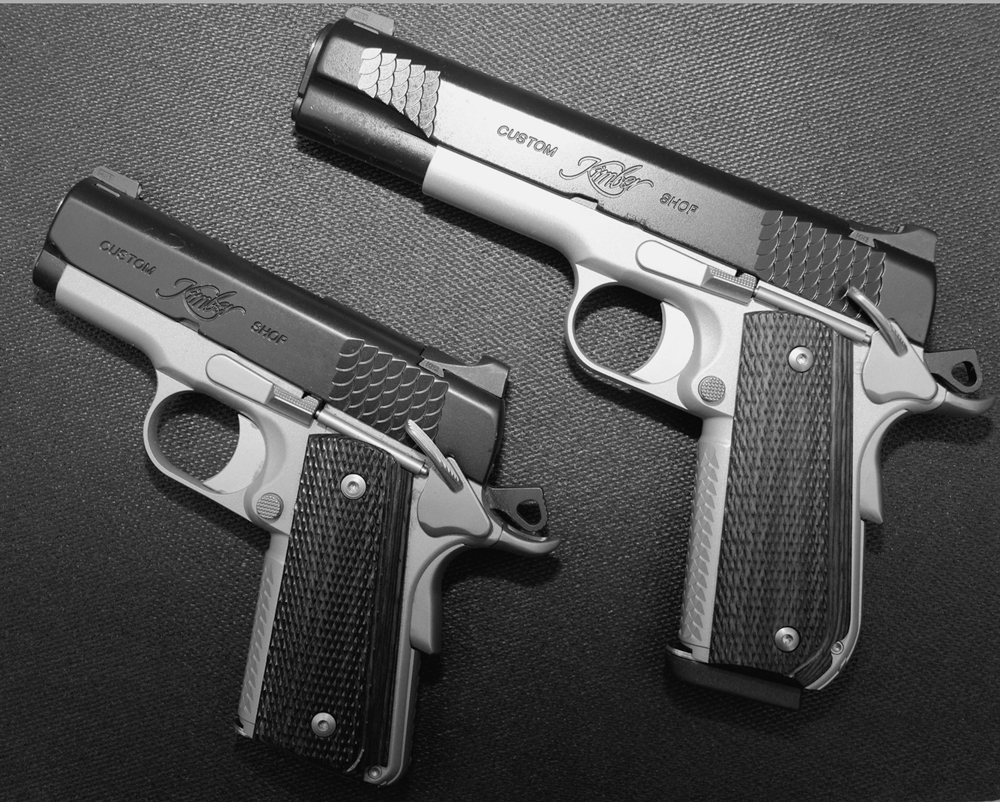
6. Strive for Manageable Recoil
Is the gun comfortable to shoot? Is the recoil manageable? Seriously, if you can’t answer “Yes” to those questions, you will not shoot it, and you won’t get in the necessary practice time. So, choose wisely. It is better to shoot a 9mm pistol accurately than a .40 S&W or a .45 ACP erratically.
7. Get a Good Trigger
You want a trigger that is neither too heavy of a pull nor too light. Bottom line—does it feel right for you? Can you operate it without getting finger cramps? Conversely, can you feel it when you press it? Too light of a trigger can spell accidental discharge. Can you repeatedly dry fire the gun without making figure eights with the front sight?
8. Seek Reasonable Accuracy
In your hands, the gun needs to be reasonably accurate when you shoot it at 10 yards and closer. Is the gun forgiving of the arc of movement created by your hand tremor? Are you able to place accurate follow-up shots? Bad guys have a nasty habit of not going down after just one shot, so good second-shot recovery is essential.
9. Demand Ease of Operation
Your defensive handgun should be simple and safe to operate. Do you have the hand strength to pull the slide all the way back on a semi-auto pistol to cycle a round into the chamber or to clear the gun? Can you easily operate the slide stop/release lever to lock the slide back? Can your thumb reach and operate the magazine catch to drop the magazine? If you have a revolver, can your thumb easily reach and operate the cylinder release latch? Under stress, whatever fine motor skills you do have tend to fly away.
Ease of operation includes choosing a gun that’s simple to field strip for routine cleaning and maintenance. Choose one that’s difficult, and the end result will be that you won’t maintain it, and then it won’t work when you need it. Keep in mind, too, that, as we age, many of us develop arthritis, which makes it difficult to disassemble and reassemble mechanical devices with many stubborn little parts. For those of us with weaker hands, it is important to choose a gun that does not require Herculean hand strength to disassemble and reassemble.
10. Affordability — Don’t Overpay!
Your gun should be affordable to purchase and use. If you’re on a fixed income, you don’t want to have to sell your firstborn grandchild to stay protected! Also, if practice ammunition is too expensive, then you may become reluctant to practice. Choose a handgun in a substantial caliber for which there’s plenty of cheap, quality target ammunition and a good supply of affordable, defensive hollowpoint ammunition—9mm would fit the bill.
Things to Think about When Living with Guns in Apartments
Things to Think about When Living with Guns in Apartments
By Mike Martel Leave a Comment
Guns in Apartments
Like many individual’s, I dream of owning a home and customizing it to exactly what I need or want. I would love to change my front window in the middle of the wall into a lovely little reading nook complete with bench, book shelving and storage space. I would love to have a room dedicated to hunting, fishing and the gear that goes with it. Or add a mirror in the hallway that has a recessed lockable cubby hole behind it; perfect for storing a couple of long guns that would be out of sight and safely tucked away.
Reality is that I live in an apartment complex where such alterations are not allowed. As an apartment dweller I realize that more than just the occupants of the apartment have keys and access to my home. Although entry into an apartment is supposed to be for maintenance purposes only I like to err on the side of caution and keep knowledge of my firearms on a need to know basis. I like to keep them locked up just in case the locks were not changed or someone got a hold of a master key. I have seen lots of turnover in staff at different apartment complexes. Being cautious doesn’t hurt anyone, but being slack could invite unwanted guests and unwanted trouble.
Like many owners of firearms there is a gun safe to lock up our firearms and other valuables. It isn’t exactly what I want in a safe but it is one that is sensible for the current living situation. It is placed where it is out of sight, unless maintenance needs to fix something in its vicinity. One lesson that has been learned while living in an apartment complex is that the size of a collection is fairly limited. There isn’t enough space for more than one safe, and creating more space is a challenge. However, keeping firearms out of sight is a priority. Apartment complexes do not afford the privacy that home ownership would. Your neighbors don’t just come and go, they move in and they move out all within a relatively short period of time.
Suitcases and book bags are a gun owner’s friend. As a college student it was very common for me to be seen with a rolling book bag. As a mother I find it to be helpful when packing everything to the car, or from the car in one trip. As a gun owner I find it to be a handy way to transporting my firearms without making my fellow apartment dwellers nervous. Or shouting that breaking in while the apartment is vacant could net you something very valuable. When buying more than just a box of ammunition, having a rolling suitcase or bag to transport it in has been splendid.
A great option that combines storage, functionality and camouflage is furniture made to havehidden compartments. There are a couple of furniture manufacturers out there that create bookcases and coffee or end tables as well as headboards. Not only does the furniture work for these multi-purposes, but it also looks great in your apartment. There are also decorative items that are functional as well as having cubby holes, such as clocks and paintings.
For those that are looking for functional furniture but want to save money, or want to be the only ones that know where the hidden compartment is DIY projects are an option as well. Most public libraries have a section on cabinetry and table building, with a few extra pieces and some creativity it is possible to create a drawer that is shorter or a hollow space where it wouldn’t be expected. One thing to keep in mind when purchasing or making items with cubby holes is if there are children in the home. Children love to explore and they are very uncanny in how fast it takes them to get into something or get somewhere that you wouldn’t expect them to.
Body Armor
Body Armor Law
Before purchasing any body armor, it is important for you to consider if it is legal for you to purchase and wear the body armor in your locality (although it is widely legal to wear and purchase body armor).
There are some restrictions that have been set forth by the United States government, as well as state level government that restrict the purchase of body armor to certain individuals. It is important for you to take the time to determine if the body armor can legally be purchased in your area. You will be ultimately accountable for ensuring that you are legally allowed to own and wear body armor in your locality.
The only way to be sure that you are allowed to purchase and wear armor is to speak with your local authority.
Connecticut State Laws
The state of Connecticut prohibits residents from buying or selling body armor that does not involve direct face to face contact. Connecticut will allow officers, the military, or police departments to buy body armor over the internet, but there are certain stipulations that must be met before the purchase will be deemed legal. If you live in Connecticut, you should find out what conditions must be met for you to make a legal purchase of the body armor.
If you have been convicted of a felony anywhere in the United States, you are likely to be prohibited from buying, owning, or wearing body armor of any kind. If a felon is caught with body armor, he or she could be subject to stiff penalties.
Background Checks?
When purchasing body armor, a background or criminal history is not run on the individual buying the body armor. That means that you need to be sure that you are legally allowed to purchase the body armor before making the final purchase. If you are caught with body armor and have a felonious criminal record, you will be held responsible for owning the body armor and will have to accept any and all consequences.
You can call your local police station to find out what the laws regarding the purchase of body armor in your locality are. This is an important step for you to take, and will ensure that you are following all of the necessary laws.
It is generally the case that law-abiding citizens are legally allowed to purchase and wear the body armor, but we thoroughly recommend that all customers seek advice from their local authority first.
- NIJ Levels
- Body Armor Law
- Hard Ballistic Plates
- Kevlar Made Vests
- Types of Body Armor
- Types of Protection
- Guide To Personal Armor
- User Guide
- Body Armor Technologies
- The Benefits of Kevlar Soft Armor
- Armor Product Life
- Police Officer Armor
- Military Body Armor
- Prison Officer Armor
- The History of Kevlar
- Security Guard Armor
- Bounty Hunters Armor
- Spike Protection
- Stab vs Bullet Proof Vest
- Stab vs Spike Protection
- Stopping the Bullet
- Civilian Protective Vests
- Protecting Border Patrol Agents
- Stab Vests for Paramedics
- Teachers Wearing Armor
Concealable Body Armor Gets More Comfortable
Concealable Body Armor Gets More Comfortable
Body armor and uniform manufacturers are developing new systems to make wearing concealable armor more comfortable.
by Bryn Bailer
 |
For decades, body armor companies have been working to make concealable ballistic vests that are lighter, cooler, more comfortable, and more likely to be worn by officers on patrol.
In the late 1990s, the industry (and many police departments) turned toward a new synthetic polymer called Zylon, which was lighter, more flexible, and stronger than Kevlar. Or so departments thought.
Following two 2003 shooting incidents involving Zylon vests that resulted in the death of an officer in California and the serious wounding of an officer in Pennsylvania, the National Institute of Justice (NIJ) decertified the “wonder fabric” for use in law enforcement ballistic vests. The NIJ’s research discovered that Zylon fibers rapidly degraded, especially under hot and humid conditions.
In response, the NIJ reexamined body armor certification standards and issued its sixth certification in 2009. The NIJ Threat Level 6 (or NIJ-6, as it is commonly called) standard resulted in the creation of vests that were sturdier, but also heavier, bulkier, and less flexible.
Since the NIJ-6 standard was issued, both law enforcement uniform and body armor manufacturers have been looking for new methods of making ballistic-resistant soft body armor that meets the dictates of the standard, but is also thinner, lighter, and more thermally bearable. They seem to be focusing on two areas: modifying the carrier and modifying the way ballistic panels are fastened to the wearer.
“The Holy Grail is the combination of ballistic protection and the decreased weight that is synonymous with officer comfort,” says Michael Haynes, director of channel development for Point Blank Enterprises/PACA, which develops, manufactures, and distributes body armor for the U.S. military and domestic and international law enforcement agencies.
In 2011, according to FBI statistics, more than 54,000 U.S. police officers were assaulted in the line of duty. Of the more than 160 who died, about 53 percent were not wearing body armor, according to the National Law Enforcement Officers Memorial Fund. Many experts believe if armor can be made more comfortable for officers to wear, then fewer officers will be killed by felonious assault in the future.
The following is a look at a few law enforcement apparel and armor companies, and how they’re changing the way you wear concealable armor.
Blauer Manufacturing
Massachusetts-based uniform manufacturer Blauer has developed an external concealable body armor carrier, called Armorskin. The ArmorSkin vest covers an officer’s conventional ballistics carrier, which is secured to the body as usual with its straps for a snug, custom fit. Unlike some other external carriers which are closed via hook-and-loop systems, Blauer’s product uses two hidden zippers to close the false uniform shirt and complete the tailored look.
The carrier’s exterior comes in a variety of fabrics, including polyester, wool blend, rayon blend, and cotton-blend ripstop, which are matched to Blauer’s ripstop shirting and pant fabric. It also includes two-way pockets with hidden document storage, epaulets, and a center mic tab. The carrier is color matched to the company’s lightweight, moisture-wicking ArmorSkin Base Shirts, which come in short- and long-sleeved models, and the same variety of fabrics. Sizes range from XS to 6XL.
“The number one reason why police officers refuse to wear armor is discomfort,” says Blauer’s Senior Vice President Stephen Blauer. “External wear of armor is the most comfortable way to wear it, as it can be removed easily [when the officer is in a safe area], allowing the officer to dry off and giving him or her a break from the heat and weight of it.”
For additional comfort, the company also offers an ArmorSkin Suspension System, a suspender-like contraption that attaches to four points on an officer’s duty belt, to rebalance the belt and equipment between shoulders and hips. It is worn under the uniform-style carrier.
 |
Elbeco
Uniform manufacturer Elbeco calls the “V” Series of its Professional Performance System the evolution of the daily uniform.
In 2011, the Pennsylvania-based company introduced its V1 External Vest Carrier to the law-enforcement market. At the time, most concealable ballistic vests were worn underneath an officer’s uniform, which was usually made of non-breathable material itself. Underneath the vest, he or she wore a T-shirt, which soaked up the heat and sweat generated by many layers of clothing.
What made the V1 different was that it was engineered to work outside of an officer’s uniform shirt and was available for both men and women in a wide range of sizes/body types.
“That’s the biggest trend right now: to wear the armor externally,” says J.D. Devine, director of sales and marketing for Elbeco.
The uniform-style carrier itself doesn’t offer ballistic, stab, or slash protection. Conventional, soft body armor panels are inserted into the external carrier’s inner pouches, and the external carrier includes functional front pockets, a badge tab, epaulettes, a mic line loop, and flexible, underarm micromesh vents. It secures with a side Velcro closure for a custom fit.
To reduce bulk, Elbeco also created the UV1, a thin, moisture-wicking knit-fabric undershirt designed to look like a uniform shirt when worn under a vest carrier. Parts of the shirt visible to the public—pointed collars, shoulders, long or short sleeves, and buttoned shirt cuffs—are made of color-matched polyester fabric to give a professional (and yes, uniform) appearance when worn with the external carrier. They come in sizes from small to 6XL.
“Until a couple years ago, the external carriers were mostly tactical, SWAT looking, and public safety administrators didn’t want to use them because they preferred the traditional look of the daily duty uniform,” Devine says. “The compromise we have found works for administration and patrol officers who don’t want to compromise the image they have always projected.”
Working in tandem with the “V” series carriers is Elbeco’s VSS1 Suspension system, a suspenders-like harness that attaches to an officer’s duty belt so the entire weight of the belt and equipment doesn’t rest on his or her hips and lower back. The suspension system itself is also worn under the external vest.
 |
KDH Defense Armor
KDH Defense Armor claims that its Transformer Armor System, which uses a harness system to directly support armor panels and hold them against the body, is revolutionary.
“With the Transformer, you wear the armor—the armor doesn’t wear you,” says Paul Larkin, the company’s national director of sales.
“A standard armor carrier holds the armor within, and does all the work,” Larkin notes. “If the shoulder straps (elastic/neoprene) stretch out over time, then the ballistics tend to drop down on the officer’s body and can expose their front or back to a potential ballistic event.”
The Transformer harness, on the other hand, attaches directly to the ballistic panels themselves, and is made of ripstop nylon that will not stretch out over time. The harness literally holds the armor in the correct position on an officer’s body.
“It’s extremely light, and not as bulky. It doesn’t even look like you have a vest on,” says Officer Mark Guillen, a veteran of the Eden (N.C.) Police Department, who has been testing the Transformer system for five months in his area’s hot, humid climate.
“A vest, when you sit down, rides up into your throat. This keeps all your plates together and tight. And if you’re outside chasing someone, or directing traffic, or running a K-9 track, instead of wearing a sweaty vest all day, you can just grab another sleeve [and change into a dry one.] It takes about a minute.”
The system comes with five standard protective sleeves per vest, so an officer can change them out at will much easier than removing a conventional ballistic vest to replace a wet, under-carrier T-shirt. Other manufacturers’ vests come with one carrier for the armor, and if an officer needs an additional carrier, he or she will need to purchase them at an average price of up to $150, according to Larkin.
The KDH suspension system can also fit into other types of carriers, including a uniform shirt sleeve, an overt vest sleeve, and a tactical MOLLE sleeve. Officers can simply then button their uniform shirt over it.
“The Transformer Armor System, which has the most ultra-concealable carrier option on the market, is the wave of the future for the law enforcement, federal and military community,” Larkin says.
 |
Point Blank Enterprises
Florida-based Point Blank develops and manufactures concealable and tactical body armor for the U.S. military; federal agencies; and city, county, and state law-enforcement and corrections agencies. Its military-style, tactical armor is designed to be “modular” and “scalable”—so that other specialized protective pieces such as throat collars or cummerbund systems—can be attached onto the basic frame.
“Those are the buzz words now,” Point Blank’s Haynes says. “You have fewer officers being tasked with a wider variety of jobs as our police forces are shrinking…. They need to be able to go from a patrol-uniform profile one minute, to then potentially responding to an active-shooter situation, which would necessitate the quick addition of rifle plates, or perhaps a full maximum-coverage tactical vest. We try to maximize building off their base ballistic platform.”
What sets concealable ballistic vests manufactured by Point Blank subsidiaries Point Blank Body Armor and PACA Body Armor apart from its competitors is a Self-Suspending Ballistic System, or SSBS. The system is comprised of shoulder harness straps connected to the front and back of ballistic carrier panels. The suspending system prevents the ballistic panels from shifting or dropping, maintaining the original shape and coverage of the carrier itself. PACA’s Blue Steel and Point Blank’s Vision carriers, manufactured in both male and female models, also include an inner lining that offers electroshock weapon protection.
For More Information:
Point Blank Enterprises, Inc./PACA
Bryn Bailer is a freelance writer based in Tucson, Ariz.
Self-Defense Lawyers
Self-Defense Lawyers
We carry to be prepared, and hope to never have a day come where we need to use our firearms. This is a great mindset, but the reality is that some of us will indeed use our firearms in a self defense situation. We’re prepared for this, but are we prepared for what happens next?
Many that carry each day do not think about the aftermath of a self defense shooting. The hectic nature immediately following a shooting is enough to rattle the strongest people you know. It can also go on for months, if not years. The last thing on your mind in this situation should be “Oh crap, I need a lawyer that’s versed in firearm laws and self defense laws that can represent me”.
Don’t end up being this person. Find a lawyer beforeyou may need one.
Choosing a lawyer versed in these categories can be a process, but it is a good idea to start the search now. Start calling a few local law offices or search the internet to see who is in your area. If you call a firm that doesn’t excel in this category, chances are they can lead you in the right direction.
Alternatively, and an even better option, is to ask people in the industry. Talk to a local firearms instructor to see if they can refer you to a lawyer in the area. If that doesn’t work out, ask around at a local gun shop to see if anyone can point you in the right direction. You can even call the NRA to get a list of lawyers in your area that have experience with self-defense cases.
Make the calls, and sit down with the lawyers to discuss what they’ve done in the past and what they have to offer you. After all, they may be getting you out of jail one day. Just like choosing a doctor, you want to be confident in your choice.
Ask them how many self-defense cases they’ve been apart of. See what their track record is. Find out of this is a person that you feel confident and secure with. If it’s 2am and you have a dead intruder in your kitchen, will you feel like you’re in safe hands when you call this lawyer right after a self-defense shooting?
It’s ok to take your time when choosing a lawyer to possibly represent you in the future, but start the process now. Even if you don’t carry yet and have a pending concealed carry application,start this process of finding a lawyer while you wait for your permit.
You prepare with everything else in your life; don’t forget this important step.
Gun Shop Etiquette
Gun Shop Etiquette
For most of you, a trip to the gun shop is like a child’s trip to Disney; You don’t ever want to leave. With these trips come unwritten rules of how to conduct yourself while browsing the fine selection of firearms and accessories. Remember that each employee at the shop speaks with many people a day, a lot of whom are new to firearms. Knowing and abiding by these unwritten rules will ensure a smooth, safe and respectful transaction.
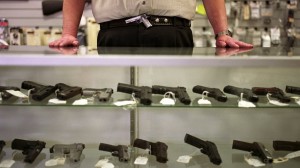
1. Look at one firearm at a time
I have been in a gun shop multiple times and witnessed a customer doing the following: “Let me look at that one, that one right there, this one over here, oh and definitely that one!” While it may be beneficial to compare them side by side, it is recommended to have just one on the counter at any given time.
2. Never cover anyone with the muzzle
As per the 4 Rules of Gun Safety, the gun is always loaded. Being in a gun shop does not make this rule any less irrelevant. When handling any firearm ANYWHERE, never let the muzzle cover anything you aren’t willing to destroy.
3. Don’t dry fire or ‘slam’ the slide without asking
I know you want to play with your potential purchase, believe me I understand! 9 times out of 10, if you want to dry fire or release the slide with the slide release, the employee will say ‘go ahead’. It’s always a good idea to ask first though, because after all, it’s their property until they sell it to you. You may also be unaware that dry-firing the firearm in your hand is actually bad for that particular firearm. Please, ask first.
4. If you’re trading in a gun, bring it in it’s case
Instead of walking up to the counter with a firearm in your hands, put it in it’s case and let the employee take it out and safety check it. This seems like common sense to me, but I’ve seen it done the other way numerous times. We’re dealing with firearms here, not jeans you’re looking to return at Wally World.
5. Always, without exception, safety check a firearm as soon as you pick it up
I don’t care if the employee just showed you it’s clear. As soon as you pick up a firearm ANYWHERE, the first thing you should be doing is a safety check. This policy does not change in a gun shop.
6. Know about the firearms you’re interested in purchasing
Do some research online before you go to the gun shop. You probably have an idea of what you’re looking to get, so check them out before you go see them. Even the best employee may not know all the answers to every single product they carry. It’s a good idea to be informed ahead of time to make sure you know exactly what you’re looking at.
7. Have your permit with you
If you’re in a state that requires you to have a permit to own a firearm, HAVE IT WITH YOU. Chances are, the gun shop can’t even let you touch a firearm without seeing your permit. Do everyone a favor and bring it with you and present it at the counter.
8. Haggling is generally ok, but don’t go overboard
If you find a firearm on BudsGunShop.com for $500 and your dealer is selling it for $589, asking for a few bucks off isn’t a bad idea. Asking them to price match however, might not be your best option. Remember that the online purchase may have other fees such as shipping, and they generally don’t have as much overhead as your dealer. He needs to keep his doors open, so haggle respectively.
9. Don’t talk about anything illegal
I’m not even going to explain this. Just…don’t do it.
10. Be respectful and courteous
Gun Shop employees see a lot of people everyday, and many are new to firearms and don’t follow the rules. I hear of ‘angry’ employees all the time, and my feeling is that they come across this way sometimes because they have people all day long doing everything on this list. Give them a break by knowing the proper Gun Shop Etiquette.
